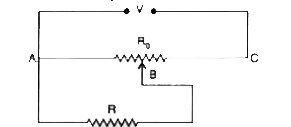For a metal the maximum wavelength required for photoelectron emission is 340 nm, find the work function. If the radiation of wavelength 250 nm falls on the surface of the given metal. Find the maximum kinetic energy of emitted photo electrons in eV. Given Planck's constant =6.625×10−34Js, velocity of light in vacuum is 3×108ms−1.Solution in Kannada
W=hcλ0
W=6.625×10−34×3×108340×10−9
W=5.84×10−34
or W=3.65eV
E=hcλ
=6.625×10−34×3×108250×10−9
=7.95×10−19J
or E=4.96eV
(K.E)max=E−W
K.Emax=2.11×10−19J or 1.31 eV
Topper's Solved these Questions
- BOOK - OSWAAL PUBLICATIONCHAPTER - DUAL NATURE OF RADIATION AND MATTEREXERCISE - TOPIC-2 DE-BROGLIE RELATION (VERY SHORT ANSWER TYPE QUESTIONS)8videos
DUAL NATURE OF RADIATION AND MATTER
- BOOK - OSWAAL PUBLICATIONCHAPTER - DUAL NATURE OF RADIATION AND MATTEREXERCISE - TOPIC-2 DE-BROGLIE RELATION (SHORT ANSWER TYPE QUESTIONS-I)9videos
DUAL NATURE OF RADIATION AND MATTER
- BOOK - OSWAAL PUBLICATIONCHAPTER - DUAL NATURE OF RADIATION AND MATTEREXERCISE - TOPIC-1 PHOTOELECTRIC EFFECT (LONG ANSWER TYPE QUESTIONS)4videos
DUAL NATURE OF RADIATION AND MATTER
- BOOK - OSWAAL PUBLICATIONCHAPTER - CURRENT ELECTRICITY EXERCISE - TOPIC-3 (POTENTIOMETER & APPLICATIONS) (NUMERICAL PROBLEMS)2videos
CURRENT ELECTRICITY
- BOOK - OSWAAL PUBLICATIONCHAPTER - ELECTRIC CHARGES & FIELDSEXERCISE - (TOPIC -2)Numerical Problems5videos
ELECTRIC CHARGES & FIELDS
Similar Questions
A proton and an electron have same kinetic energy. Which one has smaller de-Broglie wavelength ?
02:35View SolutionWhat are matter waves? Derive an expression for the de Broglie wave length.
04:03View SolutionWrite any three experimental observations of photoelectric effect
05:47View SolutionA resistance of RΩ draws current from a potentiometer. The potentiometer has a total resistance R0Ω.A voltage V is supplied to the potentiometer. Derive an expression for the voltage across R when the sliding contact is in the middle of the potentiometer.
 08:23View Solution
08:23View SolutionAn atom was earlier assumed to be sphere of radius a having a positively charged point nucleus of charge +Ze at its centre . This nucleus was believed to be surrounded by a uniform desity of negative charge that made the atom neutral as a whole.
Use this theorem to find the electric field of this atom at a distance r(r>a) from the centre of the atom.View SolutionThe work function of a metal is 1.6 xx 10^(-19) J . When the metal surface is illuminated by the light of wavelength 6400 Å , then the maximum kinetic energy of emitted photo - electrons will be (Planck's constant h = 6.4 xx 10^(-34) Js )
View SolutionWhen a metal surface is illuminated by light wavelengths 400 nm and 250 nm , the maximum velocities of the photoelectrons ejected are upsilon and 2 v respectively . The work function of the metal is ( h = "Planck's constant" , c = "velocity of light in air" )
03:42View SolutionThe maximum velocities of the photoelectrons ejected are v and 2v for incident light of wavelength 400 nm and 250 nm on a metal surface respectively. Calculate the work function of the metal. Given h=6.63×10−34J.sandc=3×108m.s−1
06:02View Solutionकिसी धातु का कार्यफलन 3.2 eV है | 300 nm तरंगदैर्ध्य वाले प्रकाश से उत्सर्जित फोटो इलेक्ट्रॉनों की अधिकतम गतिज ऊर्जा ज्ञात कीजिए | (h=6.6×10−34Js)
03:27View SolutionThe maximum kinetic energy of photoelectrons emitted from a metalic surface is 30 eV when monochromatic radiation of wavelength falls on it. When the same surface is illuminated with light of wavelength 2lambda the maximum kinetic energy photo electrons is observed to be 10 eV Calculate the wavelength lambda and determine the maximum wavelength of incident radiation for which photoelectrons can be emitted by this surface, (h = 6.62 xx 10^(-34) JS =4.14 xx 10^(-15) eV-s. c = 3 xx 10^(8) m//s)
04:40View SolutionThe kinetic energy of the emitted light electrons when light emitted at a wavelength of 500 nm falls on a light-sensitive metal plate with an emission energy of 1.235 eV [ h= 6.6 times 10^(-34) Js Suppose]
03:16View SolutionThe threshold wavelength of a photosensitive metal is 662.5 nm. If this metal is irradiated with a radiation of wavelength 331.3 nm, find the maximum kinetic energy of the photoelectrons. If the wavelength of radiation is increased to 496.5 nm, calculate the change in maximum kinetic energy of the photoelectrons. (Planck's constant h = 6.625 xx 10^(-34) Js and "speed of light in vacuum" = 3 xx 10^(8)ms^(-1) )
04:12View SolutionWhen monochromatic light of wavelength 620 nm is used to illuminate a metallic surface, the maximum kinetic energy of photoelectrons emitted is 1 eV. Find the maximum kinetic energy of photoelectron emitted (in eV) if a wavelength of 155 nm is used on the same metallic surface. (hc = 1240 eV-nm)
03:18View SolutionLight of wavelength 500 nm falls on a metal whose work function is 1.9 eV. find the kinetic energy of the photo electrons emitted.
View SolutionWhen a metal surface is illuminated by light wavelengths 400 nm and 250 nm , the maximum velocities of the photoelectrons ejected are upsilon and 2 v respectively . The work function of the metal is ( h = "Planck's constant" , c = "velocity of light in air" )
02:02View Solution

